52-year-old Female Janitor Died as a Result of a Vapor Flashback While Using Flammable Lacquer Thinner to Remove Carpet Glue From Concrete Basement Floor
Michigan Case Report: 04MI130
Summary
On September 17, 2004, a 52-year-old female janitor for a public housing commission died from burn injury complications sustained on September 9, 2004. The victim was removing carpet glue from a concrete floor in the basement “den” area of a townhouse unit with a flammable lacquer thinner. See Figure 1 for an example of a townhouse basement unit layout. The victim was assisting a co-worker in preparing the townhouse unit for a new tenant. While her co-worker was cleaning the second story of the townhouse, she proceeded to the basement. The mechanical room contained the gas hot water heater and furnace, plumbing and electrical for a washer and dryer, and a laundry tub. The victim was using the flammable lacquer thinner on the floor to soften the carpet glue so she could remove it. Although both basement rooms had 17” x 11” windows, she did not open them. It is hypothesized that she poured the lacquer thinner on the floor. The vapors from the lacquer thinner migrated into the mechanical room, contacted the open flame of the hot water heater and flashed back and burned her. Her co-worker working upstairs heard the victim scream and came to assist her. The co-worker found the victim at the top of the basement stairs and assisted her outside. The co-worker used her walkie-talkie to contact the housing commission office, and office personnel contacted 911. The victim was transported to a local hospital where she died approximately a week later.
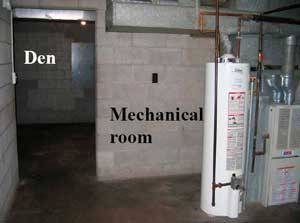 |
|
Figure 1. Victim was in “den” area at a different but similarly constructed basement.
|
Recommendations:
- Employers should develop and implement a hazard communication (Right-to-Know) program.
- Employers should investigate if substitution of water-based, non-chlorinated cleaning products in place of flammable materials used for cleaning is possible.
- Employers should develop and implement a site-specific health and safety program.
- Michigan Housing Directors Association (MHDA) should establish a Health and Safety (H&S) committee, as should each individual housing commission.
- Housing commission units should consider replacing older hot water heaters with heaters that are equipped with flammable vapor ignition resistant (FVIR) components.
- Gas hot water heater manufacturers should place fire hazard warning labels near the pilot light as well as in another observable location on the unit.
Introduction
On September 17, 2004, a 52-year-old female janitor for a public housing commission died from burn injuries sustained on September 9, 2004. The victim was removing carpet glue from a concrete floor in the basement “den” area of a townhouse unit with a flammable lacquer thinner. On September 20, 2004, MIFACE investigators were informed by the Michigan Occupational Safety and Health Administration (MIOSHA) personnel who had received a report on their 24-hour-a-day hotline that a work-related injury had occurred on September 9, 2004 and had resulted in the individual’s death nine days later. On October 26, 2004, the MIFACE researcher interviewed the Executive Director of the Housing Commission. The Director also accompanied the MIFACE researcher to a townhouse that was similarly constructed as the one in which the victim was burned. The Director permitted MIFACE to take pictures of a similarly constructed townhouse basement (Figure 1 ). During the course of writing the report, the Fire Department report and pictures, police report, medical examiner’s case report, and MIOSHA citations were obtained. Figures 2, 3, 4, 5, and 6 are pictures taken by the Fire Department at the time of their investigation.
The employer, a housing commission, administers federal funds for low-income housing. This housing commission has been at the site since 1960 and had grown in size over the years. The housing commission employed 13 people. Two people have the same job title as the victim, which is janitor. The victim was also a supervisor for all of the community service individuals and other maintenance workers. The victim worked full time, from 8:00 a.m.-4:00 p.m., and had been employed by the housing commission for seven years. Due to her work performance over the seven years of employment, she was given additional job responsibilities, such as overseeing extermination activities and crew cleanup of rental units. The Executive Director of the housing commission characterized her as a very conscientious employee.
The housing commission did not have a written Health and Safety Program. Employees had not received health and safety training. The commission did not have a Health and Safety Committee and did not have a written disciplinary procedure in place for safety and health violations. The Executive Director of the housing commission had been in that position for approximately one year and was unaware that the commission site did not have appropriate training or written programs. He was also unaware of the full extent of HUD audits and inspections. The Executive Director indicated that he was unaware of any safety training that had been conducted or that there were any special cleaning problems with that particular unit.
As a result of their inspection after the fatality, MIOSHA issued the following Serious citation to the employer regarding the Hazard Communication standard: the employer had not provided employees with effective information and training on hazardous chemicals in the work area at the time of their initial assignment and whenever a new physical or health hazard was introduced into their work area.
Investigation
Description of the Work Area: A stairway led to the basement and had a door at both the top and bottom of the stairs. The basement walls were constructed of cement block and the floors were poured concrete. The basement’s ceiling height as measured from the basement floor to the floor joists above was approximately 7’ tall. Both rooms contained a 17” x 11” window that was located approximately 5’9” up from the floor. Both windows were closed while the deceased was working. The basement was divided into two rooms, the mechanical room and the den. The stairway to the basement exited to the mechanical room. The mechanical room was 12’ x 12’ and contained a natural gas furnace, natural gas hot water heater, plumbing and electrical for a washer and dryer, and a laundry tub. A 3’ wide “door” opening allowed passage between the mechanical room and the 12’ x 15’ den (Figure 1 ).
Both the gas-fired furnace and the 40-gallon gas hot water heater were lit and operational. The hot water heater pilot light, located less than 4” above the floor was lit because hot water was needed to clean and prepare the townhouse for the next tenants (Figure 2). The hot water heater was located approximately 4 ½’ away from the door between the two rooms. The hot water heater had affixed warning signs including a sign warning of an explosion/fire hazard associated with a flammable solvent vapor on the side near the top of the unit (Figure 3). The furnace pilot light and burners were located more than 20” from the floor.
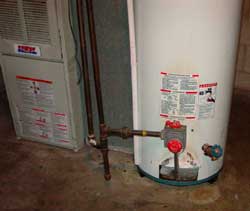
|
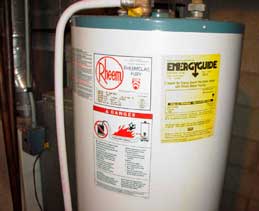
|
|
Figure 2. 40-gallon gas hot water heater warning labels near pilot light.
|
Figure 3. Location of flammable material warning label on side near top of heater.
|
The den floor had remnants of carpet glue that had not been removed when workers had previously removed carpet tiles that had been installed by the previous tenants (Figure 4).
Day of the Incident: The victim started work at approximately 7:30 a.m. on the day of the incident cleaning the office space for the Housing Commission. After finishing her work in the Administration Building, the victim proceeded to the townhouse that was being cleaned for the new tenants and assisted another co-worker. Because the den’s concrete floor was to be painted, she wanted to remove the remaining carpet glue from the floor. It is hypothesized that she poured the lacquer thinner (Figure 5) on the floor to soften the glue so she could remove it from the floor. It is unknown what tool she used to remove the glue. A push broom, still smoking from contact with the flames, was found at the scene by firefighters.
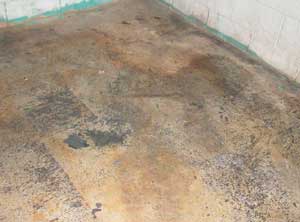
|
|
Figure 4. Carpet glue remnants on den concrete floor.
|
Although the lacquer thinner can had a legible warning label (Figure 6), she apparently was unaware of the hazards associated with using a flammable solvent indoors near an ignition source without ventilation. The flammable vapors from the thinner migrated into the mechanical room, were ignited by the hot water heater’s pilot light, and flashed back to their source in the den and burned the victim. The victim screamed and ascended the basement stairs. Her co-worker working upstairs heard the scream and came downstairs to assist her. Smoke filled the basement and first floor of the townhouse. Finding her at the top of the basement stairs, her co-worker assisted the victim outside and then used a walkie-talkie to contact the housing commission office. Office personnel contacted 911. Emergency response arrived and the victim was transported to a nearby hospital. She sustained burn injuries to her arms, face, neck, ears, legs, and back. She died approximately a week later from the injuries she sustained at the time of the incident.
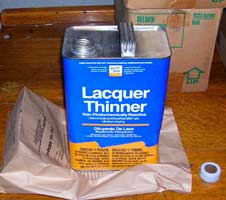
|
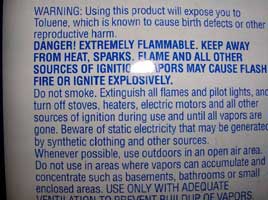
|
|
Figure 5. Flammable lacquer thinner used by victim to soften glue.
|
Figure 6. Warning label on lacquer thinner container.
|
Fire Department Inspection: The Fire Department found a metal one-gallon can of lacquer thinner in the mechanical room, and a cap consistent with the type that would cover this container located in the entryway from the mechanical room to the den.
The Fire Department reported physical evidence that provided support for a fuel vapor explosion with a pressure wave. The pressure wave closed the basement door and blew dust from the cold air return into the living room. The Fire Department investigation noted that there were small amounts of fire debris and carbon particles on the stairs and that the walls were lightly covered with soot. Both the furnace and hot water heater pilot lights were extinguished, most likely due to the pressure wave or the consumption of oxygen from the flash fire.
The Fire Department suspected that the pilot or the burner for the hot water heater was the source of the flashback because of its location less than 4” from the floor. The furnace pilot and burners were located more than 20″ from the floor level, and based on the properties of the vapor for the lacquer thinner, the water heater is suspected due to the location of the pilot. The report indicated that the volume of the vapor generated from the use of the lacquer thinner could not be accurately calculated due to the potential for numerous unknowns. These unknowns included the amount of thinner that was on the floor, the size of the pool of thinner, and the room temperature at the time of the ignition, the duration that the thinner had been sitting on the floor.
Cause of Death
The death certificate stated the cause of death as medical complications from thermal burns. An autopsy and toxicological tests were not performed.
Recommendations/Discussion
The Housing Commission should develop and implement a hazard communication (Right-to-Know) program.
The Michigan Right to Know Law, MIOSHA Hazard Communication Standard Part 92, Rule 1910.1200 mandates employers to develop a written hazard communication program. This program must evaluate the potential hazards of chemicals and communicate information concerning the identified hazards and appropriate protective measures to employees.
It is vital for employees to understand the chemical hazard information provided on chemical container labels and material safety data sheets and to apply this information as they work to minimize exposure and prevent the occurrence of adverse effects to themselves and their co-workers. In this incident, the victim was working with a flammable liquid in a poorly ventilated area. A flammable liquid is any liquid whose flash point, the temperature at which its vapors can ignite when there is a spark or open flame or static electricity, is below 100 degrees Fahrenheit. To work safely with flammable liquids, it is important to control three potential hazards: temperature, ignition sources and vapor concentration. When working with flammable materials indoors, the material should be used in a well-ventilated area that is free from ignition sources, such as heating equipment, ordinary electric equipment, open flame and sparks. Fans should have non- sparking or nonferrous blades, and the motor and controls should be explosion-proof.
Rule 1910.1200(h) details the information and training that employers must provide to employees at the time of their initial assignment and whenever a new physical hazard or health hazard the employees have not previously been trained about is introduced into their workplace. Training must equip employees with the skills to detect the presence or release of a hazardous chemical in the work area, recognize the physical and health hazards of the chemical, and the measures they can take to protect themselves from these hazards. Training must also include specific procedures that the employer has implemented to protect an employee from hazardous chemical exposure, such as appropriate work practices, emergency procedures and personal protective equipment.
The MIOSHA Consultation, Education and Training (CET) Division has developed a publication to assist employers in developing and implementing a hazard communication (Right-To-Know) program for their workplace. The sample CET Hazard Communication program can be downloaded from the MIOSHA web site at http://www.michigan.gov/documents/CIS_WSH_CET_235_49288_7.doc word iconexternal icon
Employers should investigate if substitution of water-based, non-chlorinated cleaning products in place of flammable materials used for cleaning is possible.
Although the flammable lacquer thinner was not formulated for use as a “floor-cleaning agent,” the victim used it as a cleaning agent. Many flammable materials, although not formulated for use as a cleaning agent, may be used as such by employees because the flammable material is perceived to be effective. Employers should determine if products, including flammable materials, are being used in a manner not specified by the product manufacturer. Employers should investigate if substitution of water-based, non-chlorinated cleaning products in place of flammable materials used for cleaning purposes is possible.
The Housing Commission should develop and implement a site-specific health and safety program.
The housing commission did not have a written health and safety program. The employer did not provide employee safety education and training that included hazard recognition. There were no written procedures for employee tasks at the housing commission. To assist in the development of a comprehensive health and safety program, the housing commission should conduct a job hazard analysis for existing and new work procedures as well as provide employee job hazard analysis training. Job hazard analysis training should be conducted so employees can recognize unsafe work practices and potentially hazardous work conditions when performing a task. The employer (or outside consultant) can provide hazard analysis training as part of the development and implementation of the company’s health and safety program.
A hazard analysis may have identified the potential problem of glue remaining on the floor of a space with limited ventilation, and the hazards of using a flammable product in this area. With this knowledge, substituting a water-based product to remove the glue could have been explored and additional safe work practices established. A copy of the OSHA Job Hazard Analysis publication can be found and downloaded from the OSHA web site at https://www.osha.gov/Publications/osha3071.pdfpdf iconexternal icon.
The MIOSHA Consultation, Education and Training (CET) Division have developed a sample Safety and Health Program to assist employers in developing their site-specific program. The sample program can be downloaded from the MIOSHA web site at http://www.michigan.gov/documents/lara/miosha_cetsp02_351603_7.docword iconexternal icon. (Link updated 3/25/2013)
Due to the potentially unpredictable job tasks encountered at the housing commission, ongoing hazard recognition and evaluation should be conducted. When new hazards are recognized, effective prevention and control measures should be included in a formalized safety-training plan. This training should be ongoing, and should be a requirement for all workers as well as for new workers and trainees.
Michigan Housing Directors Association (MHDA) should establish a Health and Safety (H&S) committee, as should each individual housing commission.
Some housing commissions across the State are attempting to gain more autonomy from the municipalities with whom they are associated. Autonomy from the municipalities has both advantages and disadvantages. A disadvantage to autonomy is the lack of health and safety support by the municipality; they no longer have the municipality as a resource to assist them in identifying and resolving health and safety concerns.
Housing commission directors have formed an association to provide mutual support in their effort to providing public housing to those individuals needing it. This group should consider establishing a H&S committee to discuss health and safety issues, gather existing health and safety resources and develop and disseminate health and safety information to the housing commissions across the State.
Each housing commission should form their own H&S committee that is composed of both management and employee representatives. The main incentive for developing a H&S committee is to encourage and heighten employee involvement in the safety program. Employee input is a critical part of a successful safety program. An H&S Committee is one way to obtain that input. The level of involvement by employees and degree of management commitment will determine if a H&S committee is successful. H&S committees provide a forum for employees to share their health and safety concerns and share their ideas and job experiences.
Housing commission units should consider replacing older hot water heaters with heaters that are equipped with flammable vapor ignition resistant (FVIR) components.
The Water Heater Joint Research and Development Consortium looked at a number of available technologies to address the ignition of flammable vapors by gas-fired water heaters. Arrestor plate technology was considered the best solution and thus the development of a flammable vapor ignition resistant (FVIR) water heater. This technology will help prevent flashback fires due to the ignition of flammable material vapors by trapping and burning the flammable vapors inside the heater and prevent the ignition of the vapors outside of the unit and in the room. The original American National Standards Institute (ANSI) A21.10.1-2001 has been revised in 2004. Currently, the arrestor plate technology carries ANSI performance, construction and safety standards developed by Canadian Standards Association (CSA) international, ANSI Z21.10.1-2004/CSA 4.1-2004, Gas Water Heaters Volume 1, Storage Water Heaters With Input Ratings of 75,000 Btu Per Hour or Less.
The U.S. Department of Energy adopted ANSI Z21.10.1-2001 and effective July 1, 2003, all new manufactured residential atmospherically vented gas-fired (both natural gas and propane) water heaters of 75,000 BTUs or less and with storage capacities of 30, 40, or 50 gallons had to meet this ANSI standard. July 1, 2004, was the effective compliance date for 30-, 40- and 50-gallon power-vented water heaters, and any remaining water heater models (e.g. mobile home, recreational vehicles, etc.) and commercial models had to meet a July 1, 2005, deadline. The ANSI standard did not require replacement of existing units, and older models remaining in inventory in distributors warehouses could continue to be sold until depleted. Housing commissions should conduct a survey of their units to determine the extent of use of the non-equipped FVIR water heaters and consider replacing them with FVIR units. When purchasing new hot water heaters, housing commissions should ensure that all new gas-fired hot water heaters have incorporated the FVIR technology, since there may still be pre-FVIR units available for sale, most likely for a reduced price compared to FVIR-equipped units.
Gas hot water heater manufacturers should place fire hazard warning labels near the pilot light as well as in another observable location on the unit.
Although the flammable material hazard warning sign was in plain view, its location on the side near the top of this model of hot water heater may not have drawn attention to the dangers posed by using flammable materials in the vicinity because it was not posted near the pilot light. MIFACE recommends that hot water heater manufacturers place the flammable material hazard warning sign near the pilot light in plain view as well as near the top of the unit.
References
- MIOSHA Standards cited in this report can be directly accessed from the Michigan Department of Labor and Economic Growth, MIOSHA web site http://www.michigan.gov/lara/0,4601,7-154-61256_11407_15368—,00.htmlexternal icon (Link updated 4/1/2013) . The Standards can also be obtained for a fee by writing to the following address: Michigan Department of Labor and Economic Growth, MIOSHA, MIOSHA Standards Section, P.O. Box 30643, Lansing, Michigan, 48909-8143. MIOSHA Standard Section phone number is (517) 322-1845.
- Department of Labor and Economic Growth, MIOSHA, Hazard Communication Standard Part 92, Rule 1910.1200
- Occupational Safety and Health Administration (OSHA). Job Safety Analysis. OSHA Publication 3071 2002 (Revised). Internet Resource: https://www.osha.gov/Publications/osha3071.pdfpdf iconexternal icon
- OSHA Hazard Communication reference training page: https://www.osha.gov/dsg/hazcom/MTP101703.htmlexternal icon
- American National Standard Institute (ANSI). Internet Resource for ANSI Z21.10.1-2004/CSA 4.1-2004: http://webstore.ansi.org/RecordDetail.aspx?sku=ANSI%20Z21.10.1-
2004/CSA%204.1-2004 (Link updated 12/11/2007 – no longer available 8/12/2013)
Michigan FACE Program
MIFACE (Michigan Fatality Assessment and Control Evaluation), Michigan State University (MSU) Occupational & Environmental Medicine, 117 West Fee Hall, East Lansing, Michigan 48824-1315. This information is for educational purposes only. This MIFACE report becomes public property upon publication and may be printed verbatim with credit to MSU. Reprinting cannot be used to endorse or advertise a commercial product or company. All rights reserved. MSU is an affirmative-action, equal opportunity employer. 5/19/05
MIFACE Investigation Report # 04MI130 Evaluationpdf iconexternal icon (see page 12 of report)
To contact Michigan State FACE program personnel regarding State-based FACE reports, please use information listed on the Contact Sheet on the NIOSH FACE web site Please contact In-house FACE program personnel regarding In-house FACE reports and to gain assistance when State-FACE program personnel cannot be reached.
